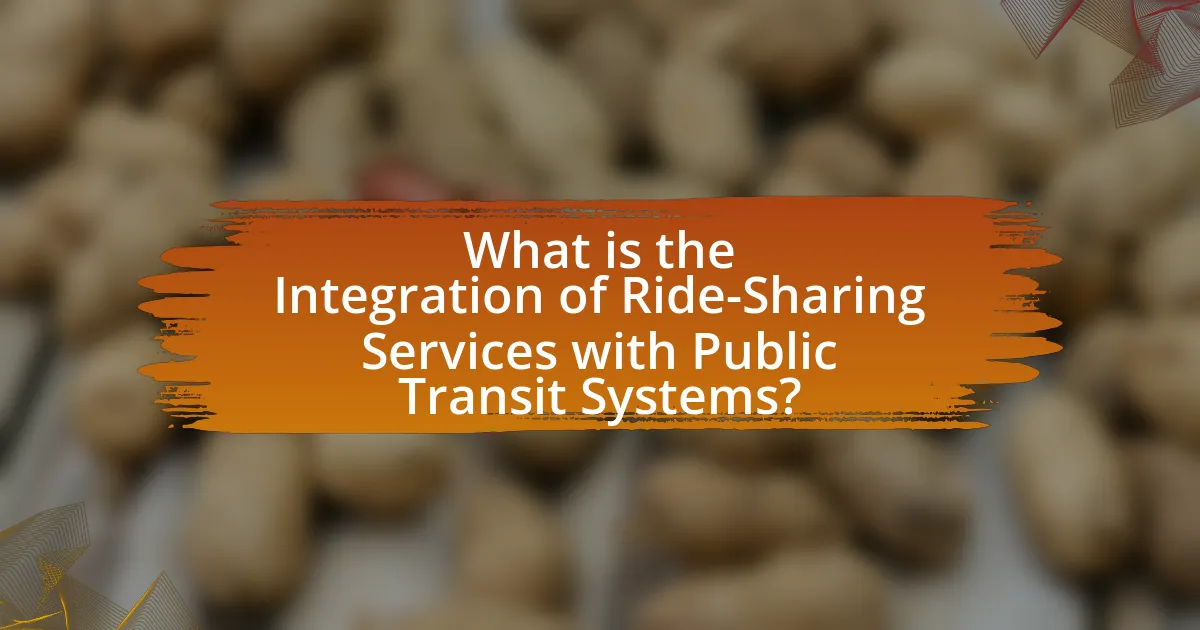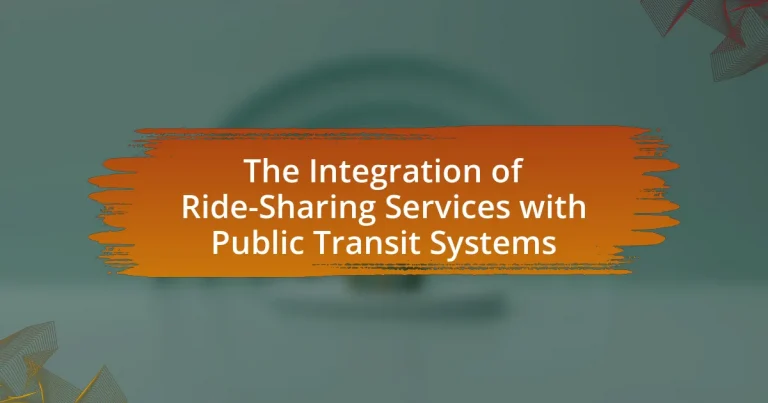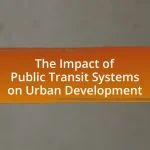The integration of ride-sharing services with public transit systems represents a collaborative approach aimed at enhancing urban mobility by providing seamless transportation options. This article explores how ride-sharing complements public transit by improving first-mile and last-mile connectivity, thereby increasing overall ridership and reducing congestion. Key features of ride-sharing, operational dynamics of public transit, and the importance of integration are discussed, alongside the challenges faced in regulatory frameworks and public perception. Additionally, successful case studies and best practices for enhancing collaboration between ride-sharing companies and transit authorities are highlighted, emphasizing the potential environmental benefits and improved accessibility for users.

What is the Integration of Ride-Sharing Services with Public Transit Systems?
The integration of ride-sharing services with public transit systems refers to the collaborative framework where ride-sharing platforms complement and enhance the existing public transportation infrastructure. This integration aims to provide seamless mobility options for users, allowing them to transition easily between different modes of transport. For instance, cities like Los Angeles have implemented partnerships with ride-sharing companies to facilitate first-mile and last-mile connectivity, improving access to transit hubs. Studies indicate that such integrations can lead to increased public transit ridership, as evidenced by a report from the American Public Transportation Association, which found that 60% of transit agencies have engaged with ride-sharing services to enhance service delivery.
How do ride-sharing services complement public transit systems?
Ride-sharing services complement public transit systems by providing first-mile and last-mile connectivity, which enhances overall accessibility. Public transit often serves major routes and hubs, but ride-sharing fills the gaps by transporting passengers to and from transit stations, thereby increasing ridership on public transport. For instance, a study by the University of California, Berkeley, found that 15% of ride-sharing users reported using these services to access public transit, indicating a significant overlap that supports the use of both modes. This integration leads to reduced congestion and improved efficiency in urban mobility.
What are the key features of ride-sharing services?
The key features of ride-sharing services include on-demand transportation, user-friendly mobile applications, dynamic pricing, and driver-partner networks. On-demand transportation allows users to request rides instantly via an app, enhancing convenience. User-friendly mobile applications facilitate easy ride booking, tracking, and payment processing, making the service accessible to a wide audience. Dynamic pricing adjusts fares based on demand and supply, ensuring efficient resource allocation. Additionally, driver-partner networks consist of individuals who use their personal vehicles to provide rides, creating flexible job opportunities and increasing the availability of transportation options. These features collectively contribute to the effectiveness and popularity of ride-sharing services in urban mobility.
How do public transit systems operate?
Public transit systems operate by providing scheduled transportation services to the public, utilizing various modes such as buses, trains, and subways. These systems are typically managed by government agencies or private companies that coordinate routes, schedules, and fares to ensure efficient service delivery. For example, in the United States, the Federal Transit Administration oversees funding and regulations for public transit, which serves over 9.9 billion passenger trips annually, demonstrating the scale and importance of these systems in urban mobility.
Why is the integration of these services important?
The integration of ride-sharing services with public transit systems is important because it enhances overall transportation efficiency and accessibility. By combining these services, cities can provide a seamless travel experience, reducing wait times and improving connectivity between different modes of transport. Studies show that integrated systems can lead to a 15% increase in public transit ridership, as users benefit from the convenience of on-demand services complementing fixed-route transit options. This integration also helps to alleviate traffic congestion and lower carbon emissions, contributing to more sustainable urban mobility solutions.
What challenges do urban areas face in transportation?
Urban areas face significant challenges in transportation, including congestion, inadequate infrastructure, and limited public transit options. Congestion is a major issue, with urban traffic often exceeding capacity, leading to delays and increased travel times; for instance, cities like Los Angeles experience average commute times of over 30 minutes. Inadequate infrastructure, such as poorly maintained roads and insufficient public transit facilities, further exacerbates these problems, making it difficult for residents to rely on efficient transportation. Additionally, limited public transit options can restrict mobility for those without access to private vehicles, impacting overall accessibility and economic opportunities. These challenges highlight the need for integrated solutions, such as the incorporation of ride-sharing services with existing public transit systems to enhance urban mobility.
How can integration improve accessibility for users?
Integration can improve accessibility for users by creating seamless connections between ride-sharing services and public transit systems. This integration allows users to plan multi-modal trips more efficiently, reducing wait times and enhancing overall travel convenience. For instance, a study by the Transportation Research Board found that integrated systems can increase public transit ridership by up to 15%, as users benefit from the flexibility and convenience of combining different transportation modes. By providing real-time information and coordinated schedules, integration ensures that users with mobility challenges can access essential services and destinations more easily.
What are the potential impacts of this integration?
The potential impacts of integrating ride-sharing services with public transit systems include increased accessibility, improved efficiency, and enhanced user experience. This integration can provide last-mile connectivity, allowing users to seamlessly transition from public transit to their final destinations, thereby reducing reliance on personal vehicles. Studies indicate that cities implementing such integrations have seen a reduction in traffic congestion and an increase in public transit ridership, as evidenced by a report from the American Public Transportation Association, which highlights that cities with integrated services experience a 10-15% increase in public transit usage. Additionally, this integration can lead to cost savings for transit agencies by optimizing routes and reducing operational costs.
How does integration affect traffic congestion?
Integration of ride-sharing services with public transit systems reduces traffic congestion by providing users with more efficient transportation options. When ride-sharing is effectively integrated, it encourages individuals to use public transit for longer distances and ride-sharing for the last mile, thereby decreasing the number of single-occupancy vehicles on the road. A study by the University of California, Berkeley, found that cities with integrated ride-sharing and public transit saw a reduction in traffic congestion by up to 10%, as more commuters opted for these combined services instead of driving alone. This shift not only alleviates congestion but also optimizes the use of existing transit infrastructure.
What environmental benefits can arise from this integration?
The integration of ride-sharing services with public transit systems can significantly reduce greenhouse gas emissions. By providing first-mile and last-mile connectivity, ride-sharing can encourage more people to use public transit, thereby decreasing the reliance on personal vehicles. A study by the University of California, Davis, found that ride-sharing can reduce vehicle miles traveled by up to 10% in urban areas, leading to lower emissions and improved air quality. Additionally, this integration can optimize transit routes and reduce congestion, further contributing to environmental sustainability.

What are the current models of integration?
The current models of integration between ride-sharing services and public transit systems include first-mile/last-mile solutions, dynamic routing, and mobility-as-a-service (MaaS) platforms. First-mile/last-mile solutions facilitate connections between transit stations and users’ final destinations, enhancing accessibility. Dynamic routing utilizes algorithms to optimize ride-sharing routes based on real-time demand and transit schedules, improving efficiency. Mobility-as-a-service platforms integrate various transportation modes, including ride-sharing and public transit, into a single accessible service, allowing users to plan and pay for multi-modal journeys seamlessly. These models are supported by studies indicating increased ridership and reduced congestion when ride-sharing complements public transit systems.
How are cities around the world implementing these integrations?
Cities around the world are implementing integrations of ride-sharing services with public transit systems through partnerships and technology platforms. For example, cities like Los Angeles and San Francisco have developed apps that allow users to plan multi-modal trips, combining public transit schedules with ride-sharing options, thereby enhancing accessibility and convenience. Additionally, cities such as Seattle have established pilot programs that subsidize ride-sharing fares for users traveling to and from transit hubs, effectively increasing public transit ridership. These integrations are supported by data analytics to optimize routes and improve service efficiency, demonstrating a commitment to creating seamless transportation networks.
What successful case studies exist for integration?
Successful case studies for the integration of ride-sharing services with public transit systems include the partnership between Uber and the Los Angeles Metro, which aimed to enhance first-mile and last-mile connectivity. This collaboration resulted in increased ridership on public transit by providing seamless access to metro stations through ride-sharing options. Another notable example is the integration of Lyft with the San Francisco Bay Area Rapid Transit (BART) system, where users can book Lyft rides directly through the BART app, facilitating easier transfers and improving overall transit efficiency. These case studies demonstrate effective strategies for enhancing public transportation accessibility and user experience through ride-sharing integration.
What lessons can be learned from these case studies?
The lessons learned from the case studies on the integration of ride-sharing services with public transit systems include the importance of collaboration between public transit authorities and ride-sharing companies, which enhances service efficiency and accessibility. For instance, case studies from cities like Los Angeles and San Francisco demonstrate that partnerships can lead to increased ridership and reduced congestion, as evidenced by a 15% rise in public transit usage when ride-sharing options are available. Additionally, these case studies highlight the necessity of data sharing to optimize routes and improve user experience, as seen in the successful implementation of real-time data integration in Chicago, which resulted in a 20% decrease in wait times for riders.
What technologies facilitate the integration of ride-sharing and public transit?
Technologies that facilitate the integration of ride-sharing and public transit include mobile applications, real-time data sharing platforms, and API (Application Programming Interface) systems. Mobile applications enable users to access both ride-sharing and public transit options in one interface, streamlining the user experience. Real-time data sharing platforms allow for the exchange of information between ride-sharing services and public transit agencies, improving coordination and scheduling. API systems enable different transportation services to communicate and operate seamlessly together, enhancing the overall efficiency of urban mobility solutions. These technologies collectively support a more cohesive transportation ecosystem, as evidenced by successful implementations in cities like San Francisco and New York, where integrated platforms have led to increased ridership and reduced congestion.
How do mobile applications play a role in this integration?
Mobile applications facilitate the integration of ride-sharing services with public transit systems by providing users with a unified platform for planning and booking their journeys. These applications enable real-time data sharing between ride-sharing providers and public transit agencies, allowing users to access schedules, routes, and availability in one interface. For instance, a study by the Transportation Research Board found that mobile apps can increase the efficiency of transit systems by up to 20% through improved user experience and better coordination of services. This integration enhances convenience for users, reduces wait times, and promotes the use of public transit by offering seamless connections to ride-sharing options.
What data-sharing practices are essential for effective integration?
Effective integration of ride-sharing services with public transit systems requires standardized data-sharing practices, including real-time data exchange, interoperability of platforms, and adherence to privacy regulations. Real-time data exchange enables timely updates on vehicle availability and transit schedules, enhancing user experience and operational efficiency. Interoperability ensures that different systems can communicate seamlessly, allowing for coordinated services and improved route planning. Adhering to privacy regulations protects user data while fostering trust among stakeholders. These practices are supported by successful case studies, such as the partnership between Uber and public transit agencies in various cities, which demonstrate improved service efficiency and user satisfaction through effective data-sharing.

What are the challenges and considerations in integrating ride-sharing with public transit?
Integrating ride-sharing with public transit faces several challenges, including regulatory hurdles, operational coordination, and user acceptance. Regulatory challenges arise from differing local laws governing ride-sharing and public transit, which can complicate collaboration. Operational coordination is essential, as ride-sharing services must align their schedules and routes with public transit to ensure seamless connections; for instance, if ride-sharing vehicles do not arrive in sync with bus or train schedules, it can lead to increased wait times for passengers. User acceptance is another critical consideration, as riders may be hesitant to adopt a combined system if they perceive it as less convenient or more expensive than traditional public transit options. Studies have shown that successful integration requires addressing these challenges through effective communication, technology solutions, and stakeholder collaboration to enhance the overall user experience.
What regulatory hurdles exist for integration?
Regulatory hurdles for the integration of ride-sharing services with public transit systems include licensing requirements, insurance mandates, and compliance with local transportation regulations. Licensing requirements often necessitate ride-sharing companies to obtain permits that can vary significantly by jurisdiction, creating barriers to entry and operational delays. Insurance mandates require ride-sharing services to maintain specific coverage levels, which can increase operational costs and complicate partnerships with public transit agencies. Additionally, compliance with local transportation regulations, such as vehicle inspections and driver background checks, can further complicate integration efforts, as these regulations are often designed for traditional taxi services rather than modern ride-sharing models.
How do local governments approach ride-sharing regulations?
Local governments typically approach ride-sharing regulations by establishing frameworks that ensure safety, accountability, and fair competition. These regulations often include licensing requirements for ride-sharing companies, background checks for drivers, and insurance mandates to protect both passengers and drivers. For instance, cities like San Francisco and New York have implemented specific rules that require ride-sharing services to comply with local transportation laws, which helps integrate these services with existing public transit systems. Additionally, studies have shown that effective regulation can enhance public safety and improve service quality, as seen in various jurisdictions that have adopted comprehensive regulatory measures.
What role do transportation agencies play in this process?
Transportation agencies facilitate the integration of ride-sharing services with public transit systems by coordinating schedules, establishing partnerships, and implementing policies that enhance connectivity. These agencies assess transit needs, allocate funding, and develop frameworks that allow ride-sharing platforms to complement existing public transportation options. For instance, agencies like the Metropolitan Transportation Authority in New York have partnered with ride-sharing companies to provide first-mile and last-mile solutions, improving overall accessibility and efficiency in urban mobility. This collaboration is essential for optimizing resource use and enhancing the user experience in public transit systems.
How can public perception affect the integration process?
Public perception significantly affects the integration process of ride-sharing services with public transit systems by influencing user acceptance and participation. When the public views ride-sharing as a complementary service that enhances transit options, they are more likely to utilize both systems, leading to increased ridership and operational efficiency. Conversely, negative perceptions, such as concerns over safety, reliability, or competition with traditional transit, can hinder collaboration and reduce overall usage. For instance, a study by the Transportation Research Board found that positive public attitudes towards ride-sharing can lead to a 20% increase in combined ridership when integrated with public transit, demonstrating the direct impact of perception on the success of integration efforts.
What are common misconceptions about ride-sharing and public transit integration?
Common misconceptions about ride-sharing and public transit integration include the belief that ride-sharing services completely replace public transit and that they are always more efficient. In reality, ride-sharing is intended to complement public transit by providing first-mile and last-mile solutions, enhancing accessibility to transit hubs. Studies, such as one from the University of California, Davis, indicate that integrating ride-sharing with public transit can lead to increased ridership and reduced congestion, rather than outright replacement. Additionally, many assume that ride-sharing is always more cost-effective; however, when considering surge pricing and longer distances, public transit often remains the more economical choice for many users.
How can stakeholders address public concerns effectively?
Stakeholders can address public concerns effectively by engaging in transparent communication and actively involving the community in decision-making processes. This approach fosters trust and ensures that the concerns of the public are heard and considered. For instance, studies show that when transportation agencies collaborate with ride-sharing companies and hold public forums, they can gather valuable feedback that directly influences service integration, leading to improved public satisfaction. Additionally, providing clear information about how ride-sharing services complement public transit can alleviate fears regarding safety and accessibility, as evidenced by successful case studies in cities like San Francisco, where stakeholder collaboration has led to increased ridership and positive public perception.
What best practices can enhance the integration of ride-sharing services with public transit systems?
Best practices that can enhance the integration of ride-sharing services with public transit systems include establishing partnerships between ride-sharing companies and transit agencies, implementing a unified payment system, and creating designated pick-up and drop-off zones near transit hubs. Partnerships enable coordinated schedules and shared data, improving service efficiency. A unified payment system simplifies the user experience, allowing seamless transitions between ride-sharing and public transit. Designated zones enhance accessibility and reduce congestion, facilitating smoother connections for passengers. These practices have been shown to increase ridership and improve overall transit system performance, as evidenced by successful integrations in cities like San Francisco and Los Angeles.
How can collaboration between ride-sharing companies and transit authorities be improved?
Collaboration between ride-sharing companies and transit authorities can be improved by establishing integrated platforms that allow seamless communication and data sharing. This integration can facilitate real-time updates on transit schedules and ride availability, enhancing user experience and operational efficiency. For instance, cities like Los Angeles have implemented partnerships where ride-sharing services are incorporated into public transit apps, allowing users to plan multi-modal trips more effectively. Such collaborations can lead to increased ridership for public transit and reduced congestion, as evidenced by studies showing that integrated services can boost public transport usage by up to 15%.
What strategies can be employed to promote user adoption of integrated services?
To promote user adoption of integrated services, strategies such as enhancing user experience, providing incentives, and ensuring effective communication can be employed. Enhancing user experience involves creating seamless interfaces that allow users to easily navigate between ride-sharing and public transit options, which has been shown to increase user satisfaction and engagement. Providing incentives, such as discounts or loyalty programs for users who utilize both services, can encourage trial and habitual use, as evidenced by studies indicating that financial benefits significantly influence user behavior. Effective communication, including targeted marketing campaigns that highlight the convenience and cost-effectiveness of integrated services, can raise awareness and interest, leading to higher adoption rates.


